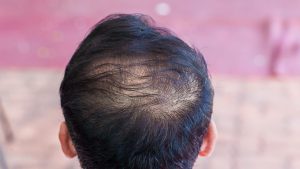Hair loss is something that a lot of people experience at some point in their lives. It’s a common problem, but it can be frustrating and difficult to deal with. However, not all types of hair loss are the same. Understanding the different symptoms associated with each type can help determine the appropriate treatment. In a Real Simple interview with trichologist William Gaunitz, WTS, he shared his expert insights on the four most common types of hair loss.

Androgenetic Alopecia:
The type of hair loss that most people experience is called androgenetic alopecia. It can happen to both men and women. This type of hair loss is driven by genetics and a sensitivity to the hormone dihydrotestosterone (DHT). Gaunitz explains that your body recognizes androgenetic alopecia as part of your genetics and, therefore, doesn’t invest the energy to regrow it. Androgenetic alopecia is a type of hair loss that can happen to anyone after they go through puberty. Typically, men will notice their hairline receding, while women will see a widening of the center part of their hair
Telogen Effluvium:
Telogen effluvium is a kind of hair loss that happens when your body experiences physical or emotional stress or trauma. Gaunitz notes that this type of hair loss leads to excessive shedding in a short period, but it is reversible. If there are no underlying conditions like androgenetic alopecia, nutritional alopecia, or inflammation, hair loss will be temporary and grow back.
Alopecia Areata:
Alopecia areata is a health condition in which the immune system of the body mistakenly attacks the hair follicles, leading to hair loss in small, circular patches about 3 millimeters in size on the top of the scalp. According to Gaunitz, this condition can also create what is called “exclamation point hair,” which looks like peach fuzz to the naked eye. Alopecia areata can advance into alopecia totalis, where hair loss spreads to the entire head, including facial hair and eyebrows. If not treated, the condition can worsen and spread throughout the entire body, leading to a complete hair loss called alopecia universalis.
Nutritional Alopecia:
Nutritional alopecia is becoming increasingly common among patients, and though it is not a medical term, Gaunitz urges the public to be aware of it. It is characterized by low blood levels of vitamin D3, serum zinc, and ferritin. If any of these three key areas are low, it can cause significant thinning in most people. Gaunitz emphasizes that nutritional alopecia should not be overlooked since it can aggravate predisposed alopecia areata or DHT-related androgenetic alopecia.
Treatment for Hair Loss:
If you are experiencing hair loss, it’s essential to visit a trichologist to get a confirmed diagnosis and personalized treatment plan. There are many remedies for hair loss, including FDA-approved drugs like Minoxidil, in-office procedures like PRP injections, and OTC scalp products and hair oils. With proper diagnosis and treatment, you can see significant results in a matter of months.
According to Gaunitz in the Real Simple interview, “If you’re losing more than 100 hairs a day, you should seek professional advice.”
Source: Gaunitz, W. (2022, January 24). 4 Common Types of Hair Loss to Know About. Real Simple. https://www.realsimple.com/types-of-hair-loss-6829987

